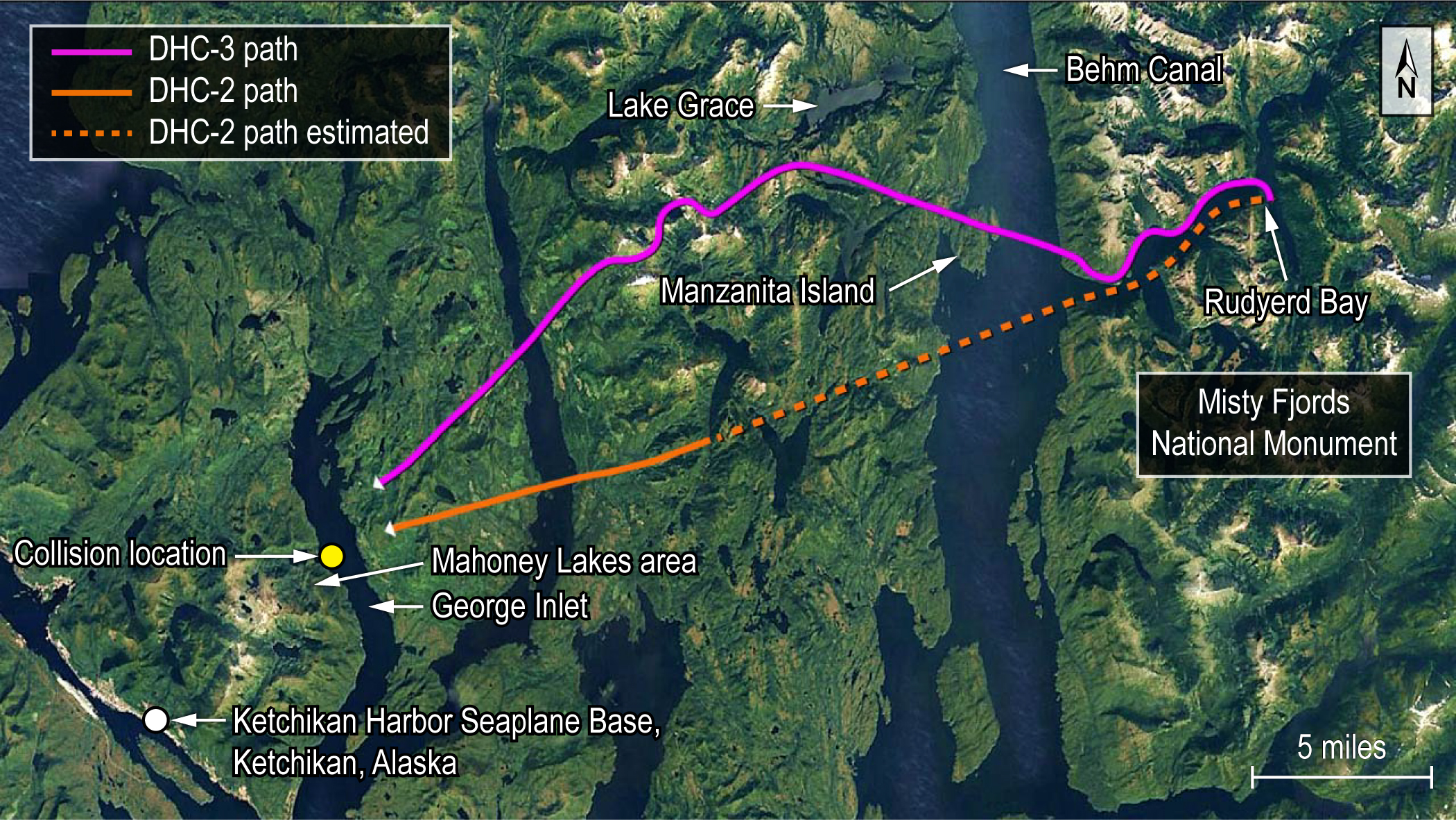WASHINGTON (April 20, 2021) — A midair collision of two air tour airplanes was caused by “the inherent limitations of the see-and-avoid concept" along with the absence of alerts from both airplanes' traffic display systems, the National Transportation Safety Board announced during a public meeting Tuesday.
“From the earliest days of powered flight, pilots have been taught to avoid other airplanes by watching out for them," said NTSB Chairman Robert L. Sumwalt. “This accident clearly demonstrates why that's just not enough. Our investigation revealed that it was unlikely that these two experienced pilots could have seen the other airplane in time to avoid this tragic outcome."
The two airplanes, a float-equipped de Havilland DHC-2 Beaver operated by Mountain Air Service and a float-equipped de Havilland DHC-3 Otter operated by Taquan Air, collided at an altitude of 3,350 feet about eight miles northeast of Ketchikan, Alaska, May 13, 2019. The DHC-2 pilot and four passengers died; the DHC-3 pilot suffered minor injuries, nine passengers were seriously injured, and one passenger died.

(This graphic shows the flightpaths of the DHC-2 and DHC-3 airplanes from the Misty Fjords National Monument area to the location of the collision eight miles northeast of Ketchikan, Alaska, May 13, 2019. NTSB overlay on a Google Earth image.)
To understand the opportunity each pilot had to identify the other airplane as the two converged, the NTSB conducted a cockpit visibility study. Using 3D laser scans of a cockpit of a DHC-2 and a DHC-3, passenger photos, recorded avionics and flight track data, investigators determined that the pilot of the DHC-2 would not have had the opportunity to see and avoid the DHC-3 because his view was obscured by the cockpit structure, right wing and a passenger in the copilot's seat. The lack of apparent motion of the DHC-2 when viewed from the DHC-3, and the obscuration of the DHC-2 by the window post for 11 seconds before the collision, made it difficult for the DHC-3 pilot to see the DHC-2 airplane.
Both airplanes' traffic display systems were equipped with ADS-B Out and In, technology designed to enhance a pilot's awareness of aircraft that may present a collision risk by providing information on the other airplanes' position (latitude, longitude, and altitude) and velocity.
Although the traffic display system installed on the DHC-3 depicted aircraft in the area, it could not provide aural or visual alerts to warn of a potential collision. The pilot of the DHC-3 last recalled looking at his traffic display about four minutes before the accident and did not identify any collision threats. A traffic alerting feature previously available in the DHC-3 was disabled by a 2015 equipment upgrade.
Unlike the DHC-3, the pilot of the DHC-2 airplane had access to a traffic display system that could provide aural and visual alerts, but the DHC-2 pilot would not have received any such alerts because the DHC-3 airplane was not broadcasting required altitude information.
"There's technology available to alert pilots to a collision risk when the see-and-avoid concept fails them," said Sumwalt. "But there were no alerts. A safety management system might have identified and mitigated the various risks associated with the limitations of the traffic display systems on each airplane. That's yet another example of why safety management systems is again on the NTSB's Most Wanted List of Transportation Safety Improvements."
Investigators said that midair collisions accounted for about seven percent of Part 135 air tour operators' fatal accidents between 1982 and 2020, more than three times the percentage of fatal midair collisions for all other aviation operations in the U.S.
Requiring all Part 135 operators, as well as all air tour operators in high-traffic areas, to be equipped with collision avoidance technology that provides visual and aural alerts, were two of the six new recommendations made to the Federal Aviation Administration Tuesday. The NTSB also reiterated a safety recommendation to the FAA for the sixth time in five years. That recommendation asked the agency to require all Part 135 operators to establish safety management systems.
Additional safety recommendations were issued to aviation industry groups asking them to inform their members of the circumstances of this midair collision and encourage their members to address ways to maximize the safety potential of traffic display and alerting equipment.
The NTSB also made recommendations to Taquan Air and the mobile application manufacturer ForeFlight.
Investigators' presentations and an abstract including the findings, probable cause and safety recommendations is available at https://go.usa.gov/xH8gj. The complete final report is expected to be published in the coming weeks.
The accident animation presented at the board meeting is available at https://www.youtube.com/watch?v=D52PoHHmcSI.
The NTSB issued a Safety Alert on collision avoidance in November 2016: https://go.usa.gov/xH8gX.
The NTSB's 2021-2022 Most Wanted List of Transportation Safety Improvements is available online at https://go.usa.gov/xH4X8.
To report an incident/accident or if you are a public safety agency, please call 1-844-373-9922 or 202-314-6290 to speak to a Watch Officer at the NTSB Response Operations Center (ROC) in Washington, DC (24/7).